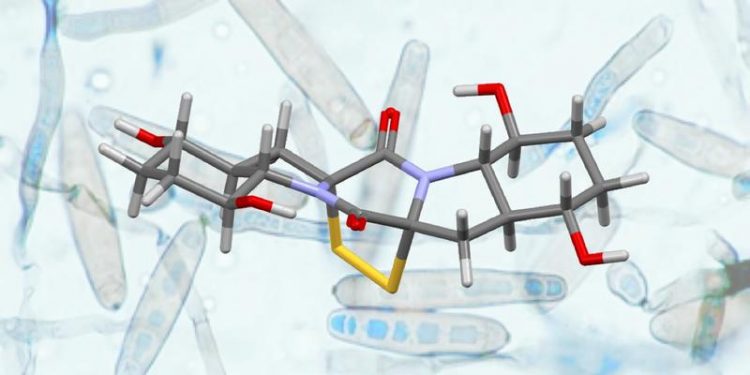A new strategy for the synthesis of complex natural products

Structure of Rostratin A (foreground) and the fungus “exserohilum rostratum” from which it was isolated (background). University of Basel, Olivier Baudoin with permission of G. Roberts
Certain microorganisms, such as fungi, are a rich source of secondary metabolites, which have great potential in medicinal applications. Of particular interest among these secondary metabolites are the dithiodiketopiperazines (DTPs), as they possess a variety of interesting biological activities that could be used in the development of new drugs for malaria or cancer.
However, despite extensive efforts over the past decade, relatively few total syntheses of these molecules have been completed and obtaining the necessary quantities for further investigation remains a challenging target.
Professor Olivier Baudoin and first author Pierre Thesmar from the Department of Chemistry at the University of Basel have now succeeded in the development of an efficient and scalable synthesis of two of these structurally challenging natural products.
C–H bond activation as a new synthetic strategy
The synthesis route used by the Basel team employed a new strategy for the ring system construction involving a method known as “C-H bond activation,” which in recent years has become a valuable synthetic tool.
In this key step, two rings are simultaneously formed by a twofold reaction in which a carbon-hydrogen bond (C-H bond) is cleaved and a carbon-carbon bond (C-C bond) formed. This route allows efficient access to a common intermediate on multigram quantities from inexpensive, commercially available starting materials.
This intermediate was then converted to the first natural DTP, Epicoccin G, in seven additional steps. Compared with the previous single total synthesis of the same molecule, the current synthesis displays 14 steps instead of 17, and a much higher overall yield of 19.6% rather than 1.5%.
Next challenge: Rostratin A
Following the successful synthesis of Epicoccin G, the research team ventured to synthesize Rostratin A, a related natural DTP, for the first time and on a larger scale. This molecule displays a number of daunting structural elements that necessitated a significant adaptation of the synthesis end-game. After much experimentation, optimization of each step and validation on multigram quantities, Rostratin A was synthesized on a 500 mg scale. Overall, this total synthesis was completed in 17 steps and with a high overall yield of 12.7%.
The new strategy reveals the high potential of the C–H bond activation method in the field of natural product synthesis. In a next step, the researchers aim to synthesize other natural DTPs and their analogues in order to conduct more advanced studies and further evaluate the medicinal potential.
Prof. Dr. Olivier Baudoin, University of Basel, Department of Chemistry, phone +41 61 207 1198, email: olivier.baudoin@unibas.ch
Pierre Thesmar, Olivier Baudoin
Efficient and divergent total synthesis of (–)-epicoccin G and (–)-rostratin A enabled by double C(sp3)–H activation
Journal of the American Chemical Society (2019), doi: 10.1021/jacs.9b09359
Media Contact
All latest news from the category: Life Sciences and Chemistry
Articles and reports from the Life Sciences and chemistry area deal with applied and basic research into modern biology, chemistry and human medicine.
Valuable information can be found on a range of life sciences fields including bacteriology, biochemistry, bionics, bioinformatics, biophysics, biotechnology, genetics, geobotany, human biology, marine biology, microbiology, molecular biology, cellular biology, zoology, bioinorganic chemistry, microchemistry and environmental chemistry.
Newest articles

A ‘language’ for ML models to predict nanopore properties
A large number of 2D materials like graphene can have nanopores – small holes formed by missing atoms through which foreign substances can pass. The properties of these nanopores dictate many…

Clinically validated, wearable ultrasound patch
… for continuous blood pressure monitoring. A team of researchers at the University of California San Diego has developed a new and improved wearable ultrasound patch for continuous and noninvasive…

A new puzzle piece for string theory research
Dr. Ksenia Fedosova from the Cluster of Excellence Mathematics Münster, along with an international research team, has proven a conjecture in string theory that physicists had proposed regarding certain equations….



